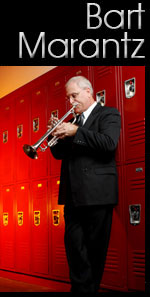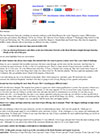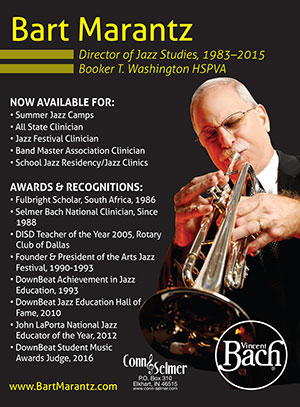 Home B.M.P. BTWHSPVA Articles Interviews Reviews Books Biography Videos Photos Calendar Music Links Contact Sara Marantz Matt Marantz Luke Marantz
Bart Marantz NPR/KERA Jazz Education Interview    Click below to listen to the interview  Click below to read the article 
|
Articles To view scans of the article click the following pages: 1, 2. Freddie Hubbard's Birdlike A Transcription and Analysis by Bart Marantz Frederick Dwayne Hubbard (Freddie), master of trumpet, flugelhorn, and piano, born in Indianapolis, Indiana on April 7, 1938, has been a mainstay in the jazz idiom since his first jazz gig with the Montgomery brothers in the late ’50s in Indianapolis. Freddie then teamed up with Sonny Rollins for about four months and later joined Slide Hampton, J.J. Johnson, and Quincy Jones, all for short stints. He was making major musical statements as a soloist even then, but didn't’t come into his own until he joined the band of Art Blakey and the Jazz Messengers in 1961. After recording with and learning from the “school” of Art Blakey, Freddie began to lead his own groups and recorded a number of albums for the Blue Note jazz label. It was during this period in the early ’60s that this recording of Birdlike was made in New York on Blue Note. There have been a number of great artists who have said, “If you can’t play it in a chorus or two, you have nothing to say!” Birdlike is the exception to the rule. There have been few jazz recordings over the blues that are as lengthy as this one with a full 19 choruses. With this in mind, I cannot think of any other solo over the blues that is played with more attention to range, color, and the ability to build and maintain interest within the 12-measure form from beginning to end over and over again. Upon a first hearing of this wonderful recording, one is immediately taken with the fact that during such a long period in the solo section Freddie never gets boring. He is always changing up his articulations, dynamics, length of notes and adding just the right amount of double-time feel as needed. Freddie’s technique is his signature and he is able to make each chorus build into the next with the touch of the master. As a student of Jerry Coker’s at the University of Miami in the early ’70s, I took a class called “Jazz Analysis” where, after many long hours of transcribing, I came up with this copy of Birdlike from the Blue Note album Ready For Freddie. Since that time I have gone back and added a few missed notes. What a joy it is to both listen to and watch this marvelous solo time and time again. To me it is one of those special moments in jazz. Later, while pursuing a masters degree at the New England Conservatory of Music in Boston, I was fortunate to hear Freddie Hubbard live at the Jazz Workshop. Sitting only a few feet from his wonderful music for a number of hours on a very cold winter evening in 1976, I listened to him in awe. That experience further strengthened my appreciation for this wonder master of jazz trumpet. I thought about the Ready For Freddie album and the Birdlike solo I had spent so many hours with a few years earlier. This live experience only confirmed what I already knew – Freddie Hubbard is one of those special innovators who mastered the art of linear, technical trumpet playing. His was a rare and special talent. In recent years Freddie has had chop problems from an incident that occurred in Europe. He discusses this in the October 1995 issues of Down Beat magazine. He mentions in that interview that he never really learned a “warm-up” for trumpet and that this has finally caught up with him in the past few years. He provided thoughtful answers to the questions submitted to him and divulged in detail his very serious chop problems as well. As a result of those problems he has had a number of surgeries on his embouchure and now plays very little, although he is still trying to make a comeback of sorts. In 1995 I wrote an article for Bach Brass Notes entitled Warming Up and Warming Down, an Essential Part of Trumpet Playing. My personal experiences underscore the need for proper warm-up preparation for the brass player. Despite his present day embouchure problems, Freddie Hubbard still maintains the respect he deserves from jazz aficionados. From his 1961 Down Beat New Star Award to the large following he had garnered just a few short years later, Hubbard has proved himself to be one of the most skillful, original, and forceful trumpeters of his time. I hope you enjoy this transcription and, as with all music, a number of listenings are recommended. I’m sure each time you hear and read this solo you will find something new and helpful. This is the mark of a master musician, and Freddie Hubbard is truly that and more. Example1 Here in chorus 2 you can see a very long flowing line. These eleven measures use the full range of the trumpet, demonstrating flowing eighth notes (all played in one breath). Example2 Here in chorus 15 Freddie has just come off a chorus of fast-moving eighth notes and, with the touch of a master, presents twelve measures of complete contrast. Here he uses tied-over long tones and punctuations of silence. As he nears the end of this chorus, you can see how he begins to set up the next chorus for another display of smokin’ eighth notes. Example3 Here in chorus 7 Freddie uses a repetitive but very simple pattern and, for the first time in this solo, he uses repeated quarter notes. It’s only at the end of this chorus that he goes back to establish the duple meter eighth note rhythmic pulse that characterizes most of this piece. Again, Freddie is using dramatic devices to break up the solo rhythmically and keep the interest in what would otherwise be a very boring long blues improvisation. Example4 Here in chorus 9 Freddie once again breaks things up in his solo approach both rhythmically and by using a “blues” type color (the Bb), always focusing in on the theme of the chorus. Once again, Freddie sets up the running eighth notes at the end of the chorus to bring the listener and this solo back to the rhythmic focus of all jazz. Complete Transcription Page One Page Two Page Three Page Four Page Five Page Six Page Seven |


